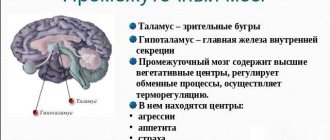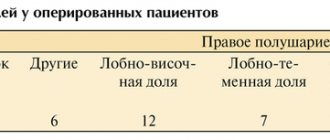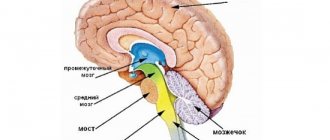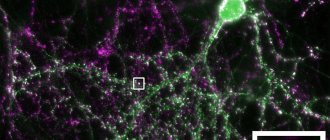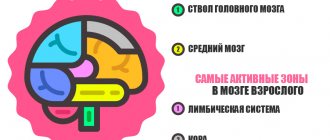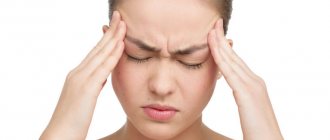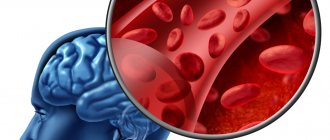A little about history
Many scientists were involved in constructing a map of the surface of the brain: Bailey, Betz, Economo and others. Their maps differed significantly from each other in the shape of the fields, their size, and number. In modern neuroanatomy, Brodmann's brain fields have received the greatest recognition. There are 52 fields in total.
Pavlov, in turn, divided all fields into two large groups:
- centers of the first signal system;
- centers of the second signaling system.
Each center consists of a core, which plays a key role in performing the function of a specific center, and analyzers surrounding the core. It is noteworthy that centers in the cerebral cortex regulate the functioning of organs on the opposite side of the body. This is due to the fact that the nerve fiber pathways cross on their way from the center to the periphery.
Brodmann's brain fields are designated by Arabic numerals, some also have a designation from which the function of a particular field can be understood.
First Signal System: Location
The centers of the first signaling system are located in Brodmann's fields, which are present in both animals and humans. They are responsible for a simple reaction to an external stimulus, the formation of sensations and ideas. These centers are present in both the right and left hemispheres of the cerebral cortex. Brodmann fields of the first signaling system are present in humans from birth and normally do not undergo changes throughout life.
These fields include:
- 1 - 3 - are located in the parietal lobe of the cerebral cortex behind the central gyrus;
- 4, 6 - located in the frontal lobe anterior to the central gyrus, they contain Betz pyramidal cells;
- 8 - this field is located anterior to the 6th, closer to the frontal part of the frontal cortex;
- 46 - located on the outer surface of the frontal lobe;
- 41, 42, 52 - located on the so-called Heschle convolutions, on the basal part of the temporal lobe of the brain;
- 40 - located in the parietal lobe behind 1 - 3 fields, closer to the temporal part;
- 17 and 19 - located in the occipital part of the brain, most dorsal from the other fields;
- 11 is one of the most ancient structures, located in the hippocampus.
Size
The volume of 10 PB in humans is on average 14 cm3, which represents 1.2% of the total brain volume. This figure is twice the standard expectation for the size of this zone in hominids with the brain volume characteristic of Homo Sapiens. By comparison, the volume of 10 PB in bonobos is about 2.8 cm3, which represents 0.74% of the total volume of the bonobo brain. The common chimpanzee has 2.24 cm3, which is 0.57% of the total brain volume; in gorillas - 1.94 cm3, or 0.55% of the total brain volume; in orangutans - 1.6 cm3, or 0.45%; in gibbons - 0.2 cm3, or 0.23%.
Important: How crazy people are treated. 1.2
In humans, each hemisphere of 10 PB contains about 250 million neurons.
The human frontopolar cortex has the lowest density of neurons of any primate. However, the dendrites of its neurons are extremely arborized, that is, very branched, and have a very high density of dendritic spines. Such structural features are the basis for the integration of incoming information from multiple brain areas.
First signaling system: functions
The functions of Brodmann's fields in the first signaling system differ depending on the location of the center and the characteristics of its histological structure. In general, these kernels perform the following functions:
- implementation of the motor process;
- recognition of objects by touch;
- hearing;
- vision.
To carry out precise movement, simultaneous activation of several Broca's areas is necessary:
- Centers 4 and 6, whose pyramidal cells carry impulses to skeletal muscles and ensure their contraction.
- Field number 40, where the centers for performing complex movements that are stereotypical for a particular person are located. These centers are formed during the life of an individual, as a rule, during professional activity.
- Sometimes it is necessary to activate field 46, which is responsible for the synchronous rotation of the eyes along with the head.
Fields numbered 5 and 7 are involved in recognizing objects by touch, or stereognosis.
Fields 41, 42 and 52 are necessary for a person to perceive the sounds of the surrounding world. Moreover, fibers from two ears at once approach the center of hearing on one side. Therefore, damage to the cortex on one side does not lead to hearing impairment. The center located in field 41 is responsible for the primary analysis of information. In field 42 there are auditory memory centers. And with the help of field number 52, a person can navigate in space.
In fields 17 to 19 there is a visual analyzer. By analogy with the auditory centers, primary analysis of information occurs in field 17, visual memory is located in field 18, and evaluation centers and orientation are located in field 19.
In field 11 there are centers of smell, in field 43 there are centers of taste.
Notes
- Brodmann Korbinian.
Vergleichende Lokalisationslehre der Grosshirnrinde : in ihren Principien dargestellt auf Grund des Zellenbaues. — Leipzig: Johann Ambrosius Barth Verlag, 1909. - S.M.Vinichuk, E.G.Dubenko, E.L.Macheret and in.
Nervous ailments (in Ukrainian). - K.: "Health", 2001. - P. 115-116. — 696 p. — 3,000 copies. — ISBN 5-311-01224-2. - Yu.I. Afanasyev, N.A. Yurina.
Histology. - M.: Medicine, 2001. - P. 316-323. — 744 p. — ISBN 5-225-04523-5. - S.M.Vinichuk, E.G.Dubenko, E.L.Macheret and in.
Nervous ailments (in Ukrainian). - K.: “Health”, 2001. - P. 128. - 696 p. — 3,000 copies. — ISBN 5-311-01224-2. - S.M.Vinichuk, E.G.Dubenko, E.L.Macheret and in.
Nervous ailments (in Ukrainian). - K.: “Health”, 2001. - P. 124. - 696 p. — 3,000 copies. — ISBN 5-311-01224-2.
Second Signal System: Location
The presence of a second signaling system is characteristic only of humans. It is these centers that provide higher thinking, which includes generalization of information, dreams, and logic. In fact, for normal thinking and speech, activation of all Brodmann fields is necessary, but centers can be distinguished that have their own specific functions:
- 44 - located in the posterior part of the inferior frontal gyrus;
- 45 - located anterior to field 44, in the anterior portion of the frontal gyrus;
- 47 - located below the two previous fields, closer to the basal part of the frontal lobe;
- 22 - one of the most anterior parts of the temporal lobe;
- 39 - located in the posterior part of the superior temporal gyrus.
Anatomy of the Human Cerebral Cortex - information:
In each hemisphere, three surfaces can be distinguished: superolateral, medial and inferior, and three edges: superior, inferior and medial, three ends, or poles: anterior pole, polus frontalis, posterior, polus occipitalis, and then polus temporalis, corresponding to the protrusion of the inferior surface and separated from it by a fossa, fossa lateralis cerebri.
The surface of the hemisphere (cloak) is formed by a uniform layer of gray matter 1.3-4.5 mm thick, containing nerve cells. This layer, called the cerebral cortex, cortex cerebri, seems to be folded, due to which the surface of the cloak has a highly complex pattern, consisting of furrows alternating in different directions and ridges between them, called convolutions, gyri.
The size and shape of the grooves are subject to significant individual fluctuations, as a result of which not only the brains of different people, but even the hemispheres of the same individual are not quite similar in the pattern of the grooves. Deep permanent grooves are used to divide each hemisphere into large areas called lobes, lobi; the latter, in turn, are divided into lobules and convolutions.
There are five lobes of each hemisphere: frontal (lobus frontalis), parietal (lobus parietalis), temporal (lobus temporalis), occipital (lobus occipitalis) and a lobe hidden at the bottom of the lateral sulcus, the so-called insula. The superolateral surface of the hemisphere is delimited into lobes by three grooves: the lateral, central and upper end of the parieto-occipital groove, which, being on the medial side of the hemisphere, forms a notch on its upper edge.
The lateral groove, sulcus cerebri lateralis, begins on the basal surface of the hemisphere from the lateral fossa and then passes to the superolateral surface, going backward and slightly upward. It ends approximately at the border of the middle and posterior thirds of the superolateral surface of the hemisphere. In the anterior part of the lateral sulcus, two small branches depart from it: ramus ascendens and ramus anterior, heading to the frontal lobe.
The total area of the adult human cortex is about 220,000 mm2, with 2/3 lying deep between the gyri and only 1/3 lying on the surface. The central groove, sulcus centralis, begins at the upper edge of the hemisphere, somewhat posterior to its middle, and goes forward and down. The lower end of the central sulcus does not reach the lateral sulcus. The part of the hemisphere located in front of the central sulcus belongs to the frontal lobe; the part of the brain surface lying posterior to the central sulcus constitutes the parietal lobe, which is delimited by the posterior part of the lateral sulcus from the underlying temporal lobe.
The posterior border of the parietal lobe is the end of the aforementioned parieto-occipital groove, sulcus parietooccipitalis, located on the medial surface of the hemisphere, but this border is incomplete, because the named groove does not extend far to the superolateral surface, as a result of which the parietal lobe directly passes into the occipital lobe. This latter also does not have a sharp boundary that would separate it from the anterior temporal lobe. As a result, the boundary between the just mentioned lobes is drawn artificially by means of a line running from the parieto-occipital sulcus to the lower edge of the hemisphere. Each lobe consists of a number of convolutions, called in some places lobules, which are limited by grooves on the surface of the brain.
The structure of the cerebral cortex. The cerebral cortex consists of six layers (plates), differing from each other mainly in the shape of the nerve cells included in them:
- the molecular plate lies directly under the pia mater and contains the terminal branches of the processes of nerve cells, intertwined in a network-like manner;
- the outer granular plate is so called because it contains numerous small grain-like cells;
- the outer pyramidal plate consists of small and medium pyramidal nerve cells;
- the inner granular plate is composed, just like the outer granular one, of small cells - grains;
- the inner pyramidal lamina contains large pyramidal cells;
- The multiforme plate borders the white matter.
Of these 6 layers, the lower ones (V and VI) are predominantly the beginning of the efferent pathways; in particular, layer V consists of pyramidal cells, the axons of which make up the pyramidal system (the pyramidal cells that give rise to the pyramidal system are located in the precentral gyrus). The middle layers (III and IV) are associated primarily with afferent pathways, and the upper layers (I and II) belong to the associative pathways of the cortex. The six-layer type of cortex varies in different areas, both in terms of the thickness and arrangement of layers, and the composition of cells.
Currently, the entire cerebral cortex is considered to be a continuous receptive surface. The cortex is a collection of cortical ends of the analyzers. From this point of view, we will consider the topography of the cortical sections of the analyzers, i.e., the most important perceptive areas of the cerebral hemisphere cortex. Cortical ends of analyzers that perceive stimuli from the internal environment of the body.
- The core of the motor analyzer, i.e., the analyzer of proprioceptive (kinesthetic) stimuli emanating from bones, joints, skeletal muscles and their tendons, is located in the precentral gyrus (fields 4 and 6) and lobulus paracentralis. This is where motor conditioned reflexes close. I. P. Pavlov explains motor paralysis that occurs when the motor zone is damaged not by damage to motor efferent neurons, but by a violation of the nucleus of the motor analyzer, as a result of which the cortex does not perceive kinesthetic stimulation and movements become impossible. The cells of the motor analyzer nucleus are located in the middle layers of the motor zone cortex. In its deep layers (V, partly VI) lie giant pyramidal cells, which are efferent neurons, which I. P. Pavlov considers as interneurons connecting the cerebral cortex with the subcortical nuclei, nuclei of the cranial nerves and the anterior horns of the spinal cord, i.e. with motor neurons. In the precentral gyrus, the human body, as well as in the posterior gyrus, is projected upside down. In this case, the right motor area is connected with the left half of the body and vice versa, because the pyramidal tracts starting from it intersect partly in the medulla oblongata and partly in the spinal cord. The muscles of the trunk, larynx, and pharynx are influenced by both hemispheres. In addition to the precentral gyrus, proprioceptive impulses (muscular-articular sensitivity) also come to the cortex of the postcentral gyrus.
- The core of the motor analyzer, which is related to the combined rotation of the head and eyes in the opposite direction, is located in the middle frontal gyrus, in the premotor area (field 8).
 Such a rotation also occurs upon stimulation of field 17, located in the occipital lobe in the vicinity of the nucleus of the visual analyzer. Since when the eye muscles contract, the cerebral cortex (motor analyzer, field) always receives not only impulses from the receptors of these muscles, but also impulses from the retina (visual analyzer, field 17), various visual stimuli are always combined with different eye positions established by the contraction muscles of the eyeball.
Such a rotation also occurs upon stimulation of field 17, located in the occipital lobe in the vicinity of the nucleus of the visual analyzer. Since when the eye muscles contract, the cerebral cortex (motor analyzer, field) always receives not only impulses from the receptors of these muscles, but also impulses from the retina (visual analyzer, field 17), various visual stimuli are always combined with different eye positions established by the contraction muscles of the eyeball. - The core of the motor analyzer, through which the synthesis of purposeful complex professional, labor and sports movements occurs, is located in the left (for right-handed people) inferior parietal lobe, in the gyrus supramarginalis (deep layers of field 40). These coordinated movements, formed according to the principle of temporary connections and developed by the practice of individual life, are carried out through the connection of the gyrus supramarginalis with the precentral gyrus. When field 40 is damaged, the ability to move in general is preserved, but there is an inability to make purposeful movements, to act - apraxia (praxia - action, practice).
- The core of the analyzer of head position and movement - the static analyzer (vestibular apparatus) in the cerebral cortex has not yet been precisely localized. There is reason to believe that the vestibular apparatus is projected in the same area of the cortex as the cochlea, i.e. in the temporal lobe. Thus, with damage to fields 21 and 20, which lie in the region of the middle and inferior temporal gyri, ataxia is observed, i.e., a balance disorder, swaying of the body when standing. This analyzer, which plays a decisive role in human upright posture, is of particular importance for the work of pilots in jet aviation, since the sensitivity of the vestibular system on an airplane is significantly reduced.
- The core of the analyzer of impulses coming from the viscera and blood vessels is located in the lower parts of the anterior and posterior central gyri.
 Centripetal impulses from the viscera, blood vessels, involuntary muscles and glands of the skin enter this section of the cortex, from where centrifugal paths emanate to the subcortical vegetative centers. In the premotor area (field 6), the unification of vegetative and animal functions takes place. However, one should not assume that only this area of the cortex influences the activity of the viscera. They are influenced by the state of the entire cortex of the cerebral hemispheres.
Centripetal impulses from the viscera, blood vessels, involuntary muscles and glands of the skin enter this section of the cortex, from where centrifugal paths emanate to the subcortical vegetative centers. In the premotor area (field 6), the unification of vegetative and animal functions takes place. However, one should not assume that only this area of the cortex influences the activity of the viscera. They are influenced by the state of the entire cortex of the cerebral hemispheres.
Nerve impulses from the external environment of the body enter the cortical ends of the analyzers of the external world.
- The core of the auditory analyzer lies in the middle part of the superior temporal gyrus, on the surface facing the insula - fields 41, 42, 52, where the cochlea is projected. Damage leads to deafness.
- The nucleus of the visual analyzer is located in the occipital lobe - fields 17, 18, 19. On the inner surface of the occipital lobe, along the edges of the sulcus calcarinus, the visual pathway ends in field 17. Here the retina of the eye is projected, and the visual analyzer of each hemisphere is connected with the visual fields and the corresponding halves of the retina of both eyes (for example, the left hemisphere is connected with the lateral half of the left eye and the medial half of the right). When the nucleus of the visual analyzer is damaged, blindness occurs. Above field 17 is field 18, when damaged, vision is preserved and only visual memory is lost. Even higher is field 19, when damaged, you lose orientation in an unusual environment.
- The nucleus of the olfactory analyzer is located in the phylogenetically ancient part of the cerebral cortex, within the base of the olfactory brain - uncus, partly the hippocampus (field 11).
- The nucleus of the taste analyzer, according to some data, is located in the lower part of the postcentral gyrus, close to the centers of the muscles of the mouth and tongue, according to others - in the uncus, in the immediate vicinity of the cortical end of the olfactory analyzer, which explains the close connection between olfactory and taste sensations. It has been established that taste disorder occurs when field 43 is damaged. The smell, taste and hearing analyzers of each hemisphere are connected to the receptors of the corresponding organs on both sides of the body.
- The core of the skin analyzer (tactile, pain and temperature sensitivity) is located in the postcentral gyrus (fields 1, 2, 3) and in the cortex of the superior parietal region (fields 5 and 7). In this case, the body is projected upside down in the postcentral gyrus, so that in its upper part there is a projection of the receptors of the lower extremities, and in the lower part there is a projection of the receptors of the head.
Since in animals the receptors for general sensitivity are especially developed at the head end of the body, in the area of the mouth, which plays a huge role in capturing food, humans have retained a strong development of mouth receptors. In this regard, the region of the latter occupies an inordinately large area in the cortex of the postcentral gyrus. At the same time, in connection with the development of the hand as an organ of labor, touch receptors in the skin of the hand sharply increased in humans, which also became an organ of touch. Accordingly, the areas of the cortex corresponding to the receptors of the upper limb are much larger than those of the lower limb. Therefore, if you draw a human figure in the postcentral gyrus, head down (to the base of the skull) and feet up (to the upper edge of the hemisphere), then you need to draw a huge face with an incongruously large mouth, a large hand, especially a hand with a thumb that is sharply larger than the rest, a small torso and small leg.
Each postcentral gyrus is connected to the opposite part of the body due to the intersection of sensory conductors in the spinal cord and partly in the medulla oblongata. A particular type of skin sensitivity - recognition of objects by touch - stereognosis (stereos - spatial, gnosis - knowledge) is connected with the cortex of the superior parietal lobule (field 7) crosswise: the left hemisphere corresponds to the right hand, the right hemisphere corresponds to the left hand.
When the superficial layers of field 7 are damaged, the ability to recognize objects by touch, with eyes closed, is lost. The described cortical ends of the analyzers are located in certain areas of the cerebral cortex, which, thus, represents “a grandiose mosaic, a grandiose signaling board” (I.P. Pavlov). Thanks to analyzers, signals from the external and internal environment of the body fall onto this “board”. These signals, according to I.P. Pavlov, constitute the first signaling system of reality, manifested in the form of concrete visual thinking (sensations and complexes of sensations - perceptions). The first signaling system is also present in animals. But “in the developing animal world during the human phase there was an extraordinary increase in the mechanisms of nervous activity. For an animal, reality is signaled almost exclusively by irritations and their traces in the cerebral hemispheres, directly arriving in special cells of visual, auditory and other receptors of the body. This is what we also have in ourselves as impressions, sensations and ideas from the surrounding external environment, both natural and our social, excluding the word, audible and visible. This is the first signaling system that we share with animals. But the word constituted a second, specifically our signal system of reality, being a signal of the first signals...” (I. P. Pavlov).
Thus, I.P. Pavlov distinguishes two cortical systems: the first and second signal systems of reality, from which the first signal system first arose (it is also present in animals), and then the second - it is found only in humans and is a verbal system. Through very long repetition, temporary connections were formed between certain signals (audible sounds and visible signs) and movements of the lips, tongue, and muscles of the larynx, on the one hand, and with real stimuli or ideas about them, on the other. So, on the basis of the first signal system, a second one arose. Reflecting this process of phylogenesis, in human ontogenesis the first signaling system is first established, and then the second. For the second signaling system to begin to function, the child needs to communicate with other people and acquire oral and written language skills, which takes a number of years.
If a child is born deaf or loses his hearing before he begins to speak, then the ability of oral speech inherent in him is not used and the child remains mute, although he can pronounce sounds. In the same way, if a person is not taught to read and write, then he will forever remain illiterate. All this indicates the decisive influence of the environment on the development of the second signaling system. The latter is associated with the activity of the entire cerebral cortex, but some areas of it play a special role in speech. These areas of the cortex are the cores of speech analyzers. Therefore, to understand the anatomical substrate of the second signaling system, it is necessary, in addition to knowledge of the structure of the cerebral cortex as a whole, to also take into account the cortical ends of speech analyzers.
- Since speech was a means of communication between people in the process of their joint work activity, motor speech analyzers developed in close proximity to the core of the general motor analyzer. The motor analyzer of speech articulation (speech motor analyzer) is located in the posterior part of the inferior frontal gyrus (area 44), in close proximity to the lower part of the motor area. It analyzes the irritations passing from the muscles involved in the creation of oral speech. This function is associated with the motor analyzer of the muscles of the lips, tongue and larynx, located in the lower part of the precentral gyrus, which explains the proximity of the speech motor analyzer to the motor analyzer of these muscles. When field 44 is damaged, the ability to make simple movements of the speech muscles, scream and even sing is preserved, but the ability to pronounce words is lost - motor aphasia (phase - speech). In front of field 44 is field 45, which relates to speech and singing. When it is affected, vocal amusia occurs - the inability to sing, compose musical phrases, as well as agrammatism - the inability to form sentences from words.
- Since the development of oral speech is associated with the organ of hearing, an auditory analyzer of oral speech has developed in close proximity to the sound analyzer. Its nucleus is located in the posterior part of the superior temporal gyrus, in the depth of the lateral sulcus (area 42). Thanks to the auditory analyzer, various combinations of sounds are perceived by a person as words that mean various objects and phenomena and become their signals (second signals). With its help, a person controls his own speech and understands someone else’s. When it is damaged, the ability to hear sounds is preserved, but the ability to understand words is lost - word deafness, or sensory aphasia. When area 22 (the middle third of the superior temporal gyrus) is damaged, musical deafness occurs: the patient does not know motives, and musical sounds are perceived by him as random noise.
- At a higher stage of development, humanity learned not only to speak, but also to write. Written speech requires certain hand movements when drawing letters or other characters, which is associated with the motor analyzer (general). Therefore, the motor analyzer of written speech is located in the posterior part of the middle frontal gyrus, near the zone of the precentral gyrus (motor zone). The activity of this analyzer is connected with the analyzer of learned hand movements necessary for writing (field 40 in the inferior parietal lobule). If field 40 is damaged, all types of movement are preserved, but the ability to make subtle movements necessary for drawing letters, words and other signs (agraphia) is lost.
- Since the development of written speech is also connected with the organ of vision, a visual analyzer of written speech has developed in close proximity to the visual analyzer, which, naturally, is located near the sulcus calcarinus, in the gyrus angularis (field 39). If the inferior parietal lobule is damaged, vision is preserved, but the ability to read (alexia), that is, to analyze written letters and compose words and phrases from them, is lost.
All speech analyzers are formed in both hemispheres, but develop only on one side (for right-handers - on the left, for left-handers - on the right) and are functionally asymmetrical. This connection between the motor analyzer of the hand (organ of labor) and speech analyzers is explained by the close connection between work and speech, which had a decisive influence on the development of the brain. When the speech motor analyzer is damaged, the elementary motor ability of the speech muscles is preserved, but the ability to speak is lost (motor aphasia). In these cases, it is sometimes possible to restore speech by long-term exercise of the left hand (in right-handed people), the work of which favors the development of the rudimentary right-sided nucleus of the speech motor analyzer.
Analyzers of oral and written speech perceive verbal signals (as I. P. Pavlov said, signals of signals, or second signals), which constitutes the second signal system of reality, manifested in the form of abstract abstract thinking (general ideas, concepts, conclusions, generalizations), which characteristic only of man. However, the morphological basis of the second signal system is not only made up of these analyzers. Since the speech function is phylogenetically the youngest, it is also the least localized.
Since the cortex grows along the periphery, the most superficial layers of the cortex are related to the second signaling system. These layers consist of a large number of nerve cells (15 billion) with short processes, thanks to which the possibility of unlimited closure function and broad associations is created, which is the essence of the activity of the second signaling system. In this case, the second signaling system does not function separately from the first, but in close connection with it, or rather on its basis, since the second signals can arise only in the presence of the first.
Second signaling system: functions
As noted above, Brodmann’s cytoarchitectonic fields of the second signaling system are necessary for the implementation of higher nervous activity. And the main difference between a person and an animal is the ability to speak.
In field 45 is the Broca Center. It is necessary for normal speech motor skills. It is thanks to the presence of this center that a person is able to pronounce words. When it is damaged, a condition called “motor aphasia” develops.
In field 44 there is the center of written speech. Impulses from this area of the cortex travel to the skeletal muscles of the fingers and hand. When it is destroyed, a person loses the ability to write, which is called “agraphia.”
Field 47 is responsible for singing. It is during the normal functioning of this center that a person can pronounce words into a chant.
In field 22 there is the Wernicke center. This is where auditory speech analysis takes place. Thanks to the normal operation of the 22nd field, a person perceives words by ear.
Field 39 is the center of visual speech. The functioning of this field allows a person to distinguish between characters written on paper. When it is damaged, a person loses the ability to read, which is called sensory alexia.
Notes[edit | edit code]
- Brodmann Korbinian.
Vergleichende Lokalisationslehre der Grosshirnrinde : in ihren Principien dargestellt auf Grund des Zellenbaues. — Leipzig: Johann Ambrosius Barth Verlag, 1909. - Sapin M. R., Bilich G. L.
Human anatomy. - M.:: "Higher School", 1989. - P. 417. - 544 p. — 100,000 copies. — ISBN 5-06-001145-3. - Gerhardt von Bonin & Percival Bailey.
The Neocortex of Macaca Mulatta. — Urbana, Illinois: The University of Illinois Press, 1925. - E. D. Chomskaya.
Neuropsychology, 4th edition. — Peter, 2008.
- Media files on Wikimedia Commons
